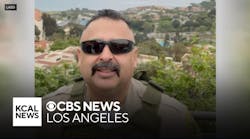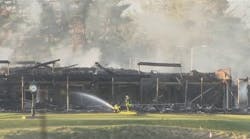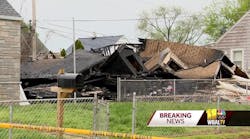Taking on the assignment of fire chief or adding more responsibilities to a member’s career for a community is a daunting challenge. It is difficult at best to make a significant impact in an organization, but nearly impossible without being prepared for the role. The preparation a member makes early in their career will go a long way in getting a higher position and the degree of success that one will enjoy while in serving in the higher post.
The “Dozen That Make the Difference” character traits presented in this series are listed in no special order or priority. Part one of this series, in the June issue, discussed the first four character traits listed in the chart on this page. The second part looks at the next four character traits a person should possess to be a good candidate as fire chief or to move up in the ranks within the department.
5. Be Honest, Direct and Clear
This month’s first next trait is being honest, direct and clear. The truth is required at all times, up and down the chain of command. There are no exceptions. Sometimes, it seems like “sugar coating” or only telling part of the truth is the way to go, but that is never a good idea. The organizational value that we trade the most on is the public trust. Without that trust, we will lose support very quickly and it will take years to rebuild it. Maintaining that most important public trust is telling the truth, even when it is not pleasant to do so. Sometimes, officers (supervisors) will not give direct and clear instructions for fear that a “direct” approach will hurt someone’s or a group’s feelings. This practice is even more common when it involves delivering bad news or corrective information. Bad news will not get better with age!
6. Learn New Systems
Next, be nimble and fast on your feet to learn the new systems of the community that you are working for as the fire chief. Perhaps you were promoted from within the ranks and you have a great understanding of all of the operating systems that make up your government. Likely, though, there are some nuances that the department head learns by being in the role. The one process that always seemed to be the slightly different from city to city is budgeting. Typically, the first step is that the budgeting office sets a departmental target amount and detailed preparation instructions are provided.
Having worked for several fire-rescue departments, it never ceased to amaze me that the budgeting processes were so similar, but the terms of art were quite different in each city. In some cases, the terms were not recognizable or even logical, so with the budget it was a lot more about learning the language, with the process being approximately the same. Disciplinary processes may change significantly from organization to organization and state to state and will require insider training to be effective.
Be a quick learner and immerse yourself into the systems that make your new agency work. This is an arena (systematic processes) that I would expect to find at least one organizational “expert” for each field. To take on the looming responsibilities of the job of chief, you will need to seek out these folks and “pick their brains,” getting as much information from them as you can.
One request I made at departments I took over was to ask everyone to hold off from retirement for at least six months to a year. First, I think that the senior members appreciated that I acknowledged their organizational experience and abilities by asking them to stay for a short while. Next, this was more of a practical concern for the organization, in that I didn’t want to experience “brain drain” until I had time to come up to speed in a wide spectrum of areas. Most members honored my request and the transition was smoother for my administration. In just a few extreme cases, I had to hire back retired members in a part-time capacity or under a short-term contact to handle a specific area of expertise. This is an effective idea, but a little more costly and may take some budget juggling with salary funding to make it work.
7. Role-Model Behaviors
You are always under the microscope and you are a role model for many. No matter what you say, when you say it and how loud you talk, your actions are being observed just about all of the time. General Colin Powell may have said it best: “Someone is always watching.” The American fire-rescue service is a highly visible and highly scrutinized function of government. Whether the agency is volunteer, career or a combination of volunteer and career firefighters, internal and external people are keeping an eye on just about everything that happens.
Think about what you are doing and how it may look to others. One of the best tests to apply is the “Mother Test” – what would your mother say about your impending behavior? If Mom would not approve, think twice and change the planned behavior.
8. Be a Lifelong Learner
The last trait that we will discuss in this month’s column is the need or thirst for lifelong learning. It seems like only yesterday that I graduated from Fairfax County, VA, Recruit School Number 20 and had learned more firematic information than seemed nearly humanly possible. Of course, the six months of intensive training and testing was only the very beginning point in my educational and fire service-learning journey. Countless seminars and classroom sessions coupled with a fire administration college degree and currently working toward a graduate degree added up, reflects the need to stay current and always looking to learn and grow. Recently, Columbia Southern University made an unprecedented step to join up with retired Phoenix, AZ, Fire Chief Alan Brunacini. About a year ago, the Brunacini Leadership Institute was established by the university’s president, Robert Mays Jr., at Columbia Southern University in Orange Beach, AL, to focus on developing and improving fire and rescue leadership at all levels. The first public offering is a program that Chief Brunacini calls “Fire Chief Leadership Retreat.” This three-day course will be offered this month at Firehouse Expo in Baltimore, MD. If you are interesting in becoming a fire chief, taking on more responsibility or in the market to improve your leadership skills, you should catch one of these outstanding programs.
Don’t over look many other ways to continue the learning and educational process as you move forward in your career. Local community colleges, state fire training institutes and the National Fire Academy are but just a few more ways to keep abreast of the changes occurring in our profession every day. I understand just how busy fire chiefs and ranking members are in every fire-rescue organization. However, the environment all around us is changing (both internally and externally) and it is very easy to become obsolete in the value we offer to our communities. The term that the leadership guru and award-winning author Stephen R. Covey uses to describe this process is to always “sharpen the saw.” Covey’s analogy of a leader as the blade of a saw is interesting and right on the money. Even the best saw blade forged from the hardest steel becomes dull over time and with use. The saw is still an outstanding tool, but only if the blade’s edge is sharpened. What a great way to remind us that training and education is a lifelong journey if you are going to stay sharp and remain on the top of your game.
Next: Community involvement






